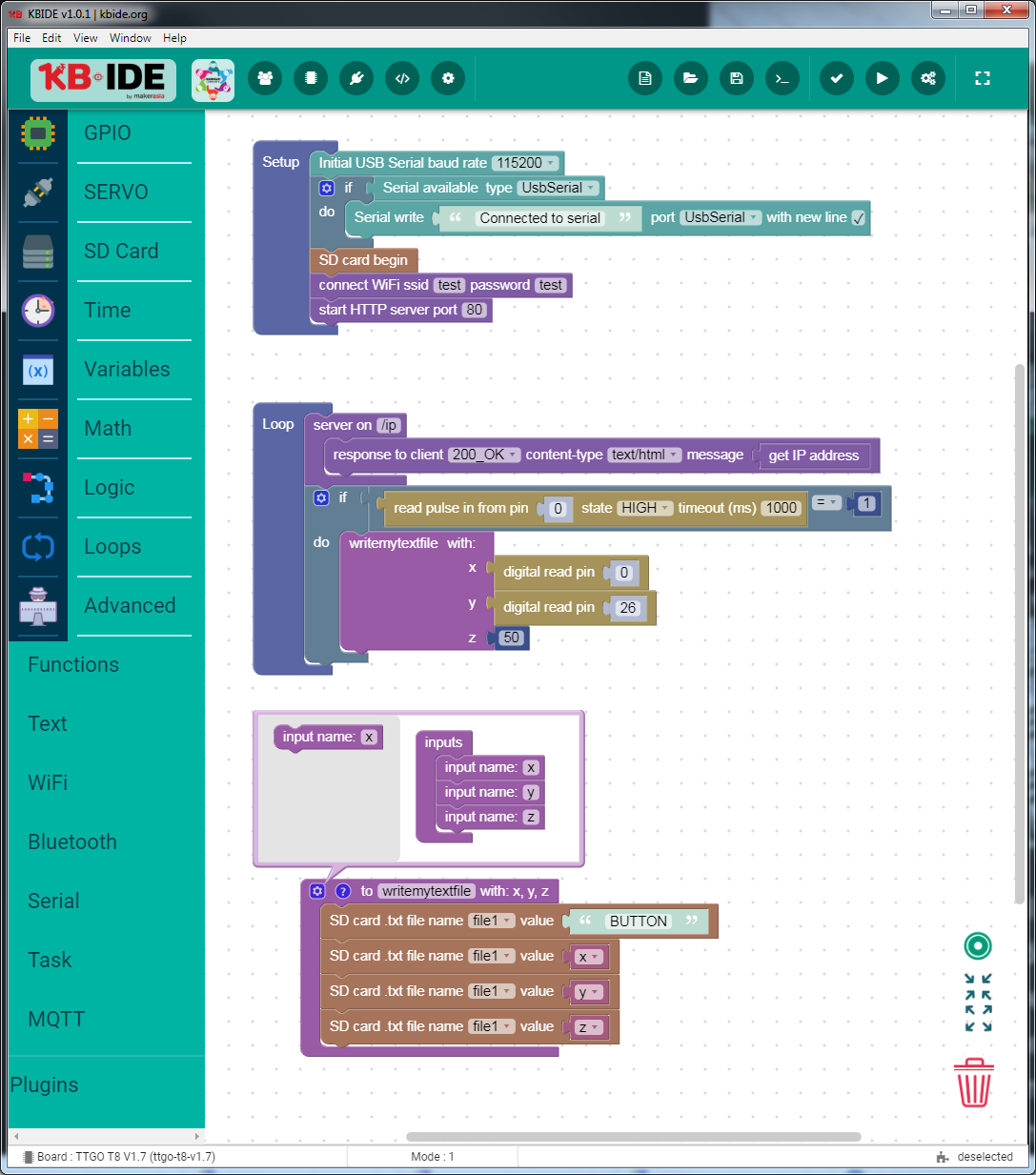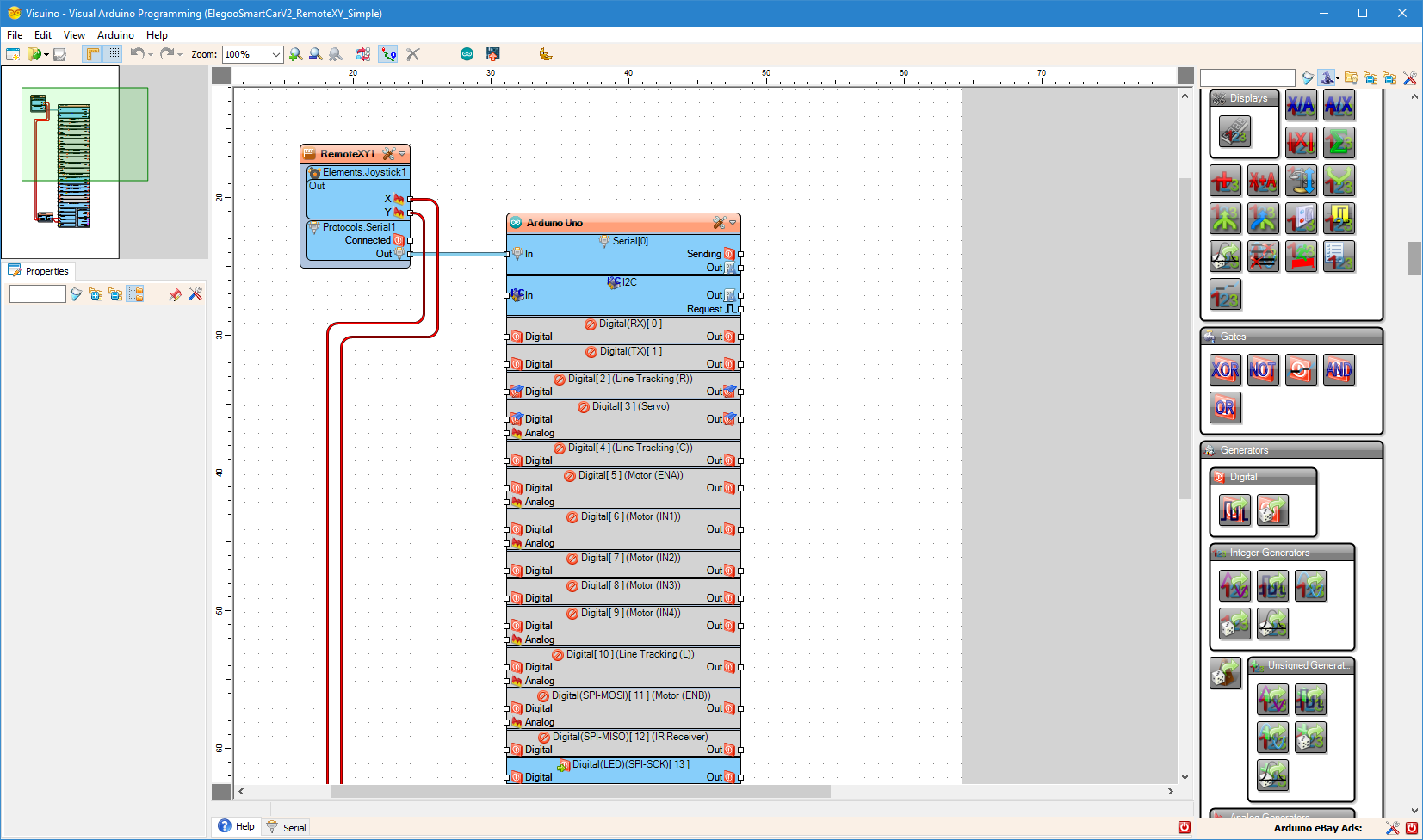
 @IRC, no, SD boot would take longer. I'm talking about an 8-pin serial Flash.
@IRC, no, SD boot would take longer. I'm talking about an 8-pin serial Flash.
 [Kamilion] normal old SPI NOR, winbond 4-bit style.
[Kamilion] normal old SPI NOR, winbond 4-bit style.
 [Kamilion] Gotcha.
[Kamilion] Gotcha.
 Hey @Joshua Donelson so good to see you here. Initial languages most likely: Spin2, MicroPython. BlocklyProp not determined. C a possibility for our development (required to get Python). This sausage is still getting made, on the Forums, within Parallax and by all of you.
Hey @Joshua Donelson so good to see you here. Initial languages most likely: Spin2, MicroPython. BlocklyProp not determined. C a possibility for our development (required to get Python). This sausage is still getting made, on the Forums, within Parallax and by all of you.
 [Kamilion] yeah, right now micropython is running on top of a RISCV ISA simulator (and still rediculously fast)
[Kamilion] yeah, right now micropython is running on top of a RISCV ISA simulator (and still rediculously fast)
 [Kamilion] i think someone else was working on a native port as well
[Kamilion] i think someone else was working on a native port as well
![]() @Joshua - We are encouraged by all the forum interest in getting other languages implemented. MicroPython, Spin, C. We haven't decided yet when we'll implement Blockly and what language(s) it will generate.
@Joshua - We are encouraged by all the forum interest in getting other languages implemented. MicroPython, Spin, C. We haven't decided yet when we'll implement Blockly and what language(s) it will generate.
![]() Yes, P1 reliably runs at -40C/-40F. I believe I had a P1 payload operating down to -50C once, but will need to check. The lipo batteries really die at these temps, so likely the P1 was not the issue when the payload stopped transmitting.
Yes, P1 reliably runs at -40C/-40F. I believe I had a P1 payload operating down to -50C once, but will need to check. The lipo batteries really die at these temps, so likely the P1 was not the issue when the payload stopped transmitting.
 The P2 has deep debugging hooks, so I look forward to making a very fast Spin2 compiler (hit the key and your code is running 100ms later), with a really thorough and interactive debugger. The more you can quickly see and interact with your code, the better stuff you can make.
The P2 has deep debugging hooks, so I look forward to making a very fast Spin2 compiler (hit the key and your code is running 100ms later), with a really thorough and interactive debugger. The more you can quickly see and interact with your code, the better stuff you can make.
![]() When start-up time is critical, it would be pretty easy to chain load from flash to an SD card, and do timing-critical initiation from flash, while the SD card code is booting in another cog.
When start-up time is critical, it would be pretty easy to chain load from flash to an SD card, and do timing-critical initiation from flash, while the SD card code is booting in another cog.
![]() to solve motor driver problem while booting, use external pullup or pulldown resistors. Yes it is assitional complexy to schematics, but safety first! On any MCU. P2 can work in two stage bootloading. Boot quickly minimal code from EEPROM and set-up safety. Then boot from SD card.
to solve motor driver problem while booting, use external pullup or pulldown resistors. Yes it is assitional complexy to schematics, but safety first! On any MCU. P2 can work in two stage bootloading. Boot quickly minimal code from EEPROM and set-up safety. Then boot from SD card.
![]() @Ken Gracey (Parallax) Thanks, that is a great way to do it.
@Ken Gracey (Parallax) Thanks, that is a great way to do it.
![]() Like in good old P1 times.
Like in good old P1 times.
 [Kamilion] JDat: the start up delay comment was more about FPGAs requiring time to load the bitstream before being ready to rumble; just so we're crystal
[Kamilion] JDat: the start up delay comment was more about FPGAs requiring time to load the bitstream before being ready to rumble; just so we're crystal
![]() @JDat what happens is that users don't understand the need for bootup time and fail to include those pull resistors. Of course they should... but people don't always.
@JDat what happens is that users don't understand the need for bootup time and fail to include those pull resistors. Of course they should... but people don't always.
![]() @Jeff Martin (Parallax) Personally I like the text programming methods over the graphics style, so Spin, C, Python are all good with me. :)
@Jeff Martin (Parallax) Personally I like the text programming methods over the graphics style, so Spin, C, Python are all good with me. :)
 Antifuse or Flash-based FPGA (from ex-Actel) have no startup time problems :)
Antifuse or Flash-based FPGA (from ex-Actel) have no startup time problems :)
 [Kamilion] yeah, my personal preference is using the micropython REPL to live-code
[Kamilion] yeah, my personal preference is using the micropython REPL to live-code
![]() in FPGA/CPLD it can be solved with zero boot time models
in FPGA/CPLD it can be solved with zero boot time models
 Text programming is hard to beat, once you know what you're doing. It's amazing how much can be expressed compactly with 7-bit ASCII.
Text programming is hard to beat, once you know what you're doing. It's amazing how much can be expressed compactly with 7-bit ASCII.
![]() We have BLDC servo motor drive in our to-do list, so it could just be a matter of implementing our reference design and having the FET drivers connected straight to I/O pins.
We have BLDC servo motor drive in our to-do list, so it could just be a matter of implementing our reference design and having the FET drivers connected straight to I/O pins.
 Interested to know if all of you see Python for P2 as primarily intended for an educational audience, or for commercial product development? Of course, you may ask "but what other languages could I choose from?" But I ask primarily about the role of MicroPython and P2, based on what you know, think, prefer.
Interested to know if all of you see Python for P2 as primarily intended for an educational audience, or for commercial product development? Of course, you may ask "but what other languages could I choose from?" But I ask primarily about the role of MicroPython and P2, based on what you know, think, prefer.


 [Kamilion] kbIDE's been getting a lot better recently.
[Kamilion] kbIDE's been getting a lot better recently.
![]() I have lots of programs written in PropC ... will they run on P2 ?
I have lots of programs written in PropC ... will they run on P2 ?
 [Kamilion] Generally, I'm happy with micropython as long as _thread is available. I use it heavily on the ESP32 and IMXRT1062
[Kamilion] Generally, I'm happy with micropython as long as _thread is available. I use it heavily on the ESP32 and IMXRT1062

 [Kamilion] @hologram70: I think Catalina should be able to rebuild for P2 without much of an issue.
[Kamilion] @hologram70: I think Catalina should be able to rebuild for P2 without much of an issue.

 [Kamilion] it *CAN* be, of course, but is anyone willing to actually go define the blocks for it?
[Kamilion] it *CAN* be, of course, but is anyone willing to actually go define the blocks for it?
![]() I'm personally avoiding all thing Python. It strikes me as todays BASIC and I think it will (as BASIC did) mislead a lot of young programmers into poor practices / misunderstandings about what's actually going on inside. Y'all will laugh, but I think people who want to program for a living should learn from digital logic, to asm, to C, and then maybe JavaScript or some other commonly used language. People who will NOT be programmers and just want to dick around with code should use Python.
I'm personally avoiding all thing Python. It strikes me as todays BASIC and I think it will (as BASIC did) mislead a lot of young programmers into poor practices / misunderstandings about what's actually going on inside. Y'all will laugh, but I think people who want to program for a living should learn from digital logic, to asm, to C, and then maybe JavaScript or some other commonly used language. People who will NOT be programmers and just want to dick around with code should use Python.
![]() @hologram70 - Forum user ntosme2 indicated he's working on GCC for P2.
@hologram70 - Forum user ntosme2 indicated he's working on GCC for P2.

 I'm a fan of C programming using 7-bit ASCII. We saw a presentation from the PART team (Placer robotics) and they're doing their codng in C++. Just sayin', in case there's an argument for appealing to high school-level robotics programmer usage of P2.
I'm a fan of C programming using 7-bit ASCII. We saw a presentation from the PART team (Placer robotics) and they're doing their codng in C++. Just sayin', in case there's an argument for appealing to high school-level robotics programmer usage of P2.
 [Kamilion] should be noted though, GCC's had huge flux since the 4.x/5.x era... It may take some time before GCC7/GCC8 patches have the bugs shaken out.
[Kamilion] should be noted though, GCC's had huge flux since the 4.x/5.x era... It may take some time before GCC7/GCC8 patches have the bugs shaken out.
 @James Newton that's me. NOT a programmer by function, but I feel incredibly productive with blocks, Python and BASIC.
@James Newton that's me. NOT a programmer by function, but I feel incredibly productive with blocks, Python and BASIC.
![]() 100 % disagree , python is useful
100 % disagree , python is useful
![]() @James Newton - I think they'll always be a need for the right tool for the right job... and the right tool handler...
@James Newton - I think they'll always be a need for the right tool for the right job... and the right tool handler...

![]() Funny story with programming languages: I programmed SPIN code for barometric pressure sensor (up to 48 bit mathematic to compensate thermal error).
Funny story with programming languages: I programmed SPIN code for barometric pressure sensor (up to 48 bit mathematic to compensate thermal error).
![]() Learning logic isn't as hard as it used to be, especialy with fantastic sites like:
Learning logic isn't as hard as it used to be, especialy with fantastic sites like:
![]() One goy translated my spin code to python...
One goy translated my spin code to python...
 [Kamilion] @James Newton: Only thing that's really an issue with python is that they made one mistake: Not everything is an object. Perl figured that out long ago, python3's still stuck.
[Kamilion] @James Newton: Only thing that's really an issue with python is that they made one mistake: Not everything is an object. Perl figured that out long ago, python3's still stuck.
![]() next guy translated python to arduino C/C++
next guy translated python to arduino C/C++
![]() As I said, if your not going to be a programmer by trade, Python is fine. Just copy paste, adjust, and you can get "somthing" working quickly.
As I said, if your not going to be a programmer by trade, Python is fine. Just copy paste, adjust, and you can get "somthing" working quickly.
 what scripting languages do you prefer?
what scripting languages do you prefer?
![]() why da hech barometer stopped to work on arduino? :D
why da hech barometer stopped to work on arduino? :D
 @Boian Mitov no, not yet. I'm going to look at Visuino and kbIDE after reading this, though.
@Boian Mitov no, not yet. I'm going to look at Visuino and kbIDE after reading this, though.
![]() Perl and javascript are excellent.
Perl and javascript are excellent.
 why is javascript excellent
why is javascript excellent

![]() "everythings an object" (or almost everything).
"everythings an object" (or almost everything).
![]() Personally I really like spin but Python is a great way to go for education market. All the engineering as cs students at Smith (where I teach) are learning Python these days. I really value having access to a local (non-cloud) compiler, even if it is simplistic. Currently I use the Propeller Tool in Windows and increasingly Propeller IDE with Ubuntu..
Personally I really like spin but Python is a great way to go for education market. All the engineering as cs students at Smith (where I teach) are learning Python these days. I really value having access to a local (non-cloud) compiler, even if it is simplistic. Currently I use the Propeller Tool in Windows and increasingly Propeller IDE with Ubuntu..
 hmm, not sure i get that, python has far more useful libraries implemented in it than JS imo
hmm, not sure i get that, python has far more useful libraries implemented in it than JS imo
![]() Chip - tell us some features of the P2 you're really excited about.
Chip - tell us some features of the P2 you're really excited about.
 Of late, I got a drum kit from a musician friend here. It's a lot of fun to play drums. It really stretches your lymbic independence and you can experience new abilities wiring up in your brain over minutes and days. This is kind of how I see programming ought to be - really allowing new things to form up. It's a lot of fun. This video (maybe watch later) demonstrates the feeling of how I want P2 programming to be:
Of late, I got a drum kit from a musician friend here. It's a lot of fun to play drums. It really stretches your lymbic independence and you can experience new abilities wiring up in your brain over minutes and days. This is kind of how I see programming ought to be - really allowing new things to form up. It's a lot of fun. This video (maybe watch later) demonstrates the feeling of how I want P2 programming to be:
![]() I'm sad people moved away from Perl. Where else can you "open file or die" or "print "hello" if ready" or embed a regexp and really confuse yourself? LOL. I wish there was a micro version of JavaScript like microPython. Then there would be "one language to rule them all". ,o)
I'm sad people moved away from Perl. Where else can you "open file or die" or "print "hello" if ready" or embed a regexp and really confuse yourself? LOL. I wish there was a micro version of JavaScript like microPython. Then there would be "one language to rule them all". ,o)
 @jeff, new features that I'm enthused about.... All the ADC functions with SINC2 and SINC3 filtering, Goertzel input with SINC2, Scope pin modes, the CORDIC solver. All together, it's going to be a blast.
@jeff, new features that I'm enthused about.... All the ADC functions with SINC2 and SINC3 filtering, Goertzel input with SINC2, Scope pin modes, the CORDIC solver. All together, it's going to be a blast.
 microJS ? I'd use it :-D
microJS ? I'd use it :-D
 Agreed. I miss Perl poetry
Agreed. I miss Perl poetry
![]() So @Chip Gracey do you want to comment on WHY it took so long to finish P2? Impossibly difficult? Distractions? Depressions? Abducted by Aliens?
So @Chip Gracey do you want to comment on WHY it took so long to finish P2? Impossibly difficult? Distractions? Depressions? Abducted by Aliens?
 CORDIC ? :)
CORDIC ? :)
 best language is APL, but only with the special APL keyboard
best language is APL, but only with the special APL keyboard
 haha
haha
![]() Has to be alien abduction, only logical option :)
Has to be alien abduction, only logical option :)
 @james, it was a bit of everything. My dad asked me a few years ago if I'd like to just quit it. I had thought about it, but it kind of has been a force of its own. If all the work that's gone into could be made manifest in the physical, I think there'd be a spaceship.
@james, it was a bit of everything. My dad asked me a few years ago if I'd like to just quit it. I had thought about it, but it kind of has been a force of its own. If all the work that's gone into could be made manifest in the physical, I think there'd be a spaceship.
![]() Sounds like the ADC stuff will allow the P2 to be a serious DSP tool?
Sounds like the ADC stuff will allow the P2 to be a serious DSP tool?
![]() I think the way of the future is real-time responsive programming. I mean, the users does something and gets immediate feedback (no crazy long compilation + downloading delay). Then, you can see the results of your actions and learn from them intrinsically. REPL systems are close to this, but I mean something with more visual feedback. Many great things have been invented by accident when something unexpected was noticed... the same kind of thing can occur if users had immediate feedback, always, while programming.
I think the way of the future is real-time responsive programming. I mean, the users does something and gets immediate feedback (no crazy long compilation + downloading delay). Then, you can see the results of your actions and learn from them intrinsically. REPL systems are close to this, but I mean something with more visual feedback. Many great things have been invented by accident when something unexpected was noticed... the same kind of thing can occur if users had immediate feedback, always, while programming.
![]() @Chip Gracey I understand exactly how certain ideas / projects can become their own entities. Almost freestanding from the developer. Sometimes they become the villain of the story. I've been tortured by a few and had to escape. But I'm always drawn back eventually.
@Chip Gracey I understand exactly how certain ideas / projects can become their own entities. Almost freestanding from the developer. Sometimes they become the villain of the story. I've been tortured by a few and had to escape. But I'm always drawn back eventually.
![]() @Yann Guidon / YGDES - https://en.wikipedia.org/wiki/CORDIC
@Yann Guidon / YGDES - https://en.wikipedia.org/wiki/CORDIC

 @james, a lot of what's in the P2 is way beyond what I could ever come up with. People on the forum have had huge effects on the direction of the project.
@james, a lot of what's in the P2 is way beyond what I could ever come up with. People on the forum have had huge effects on the direction of the project.
![]() @Jeff Martin (Parallax) That's one of the things I love about digital logic: Poking it and seeing what happens instantly.
@Jeff Martin (Parallax) That's one of the things I love about digital logic: Poking it and seeing what happens instantly.
 Jeff : yes I know, it's awesome to have it :-) I try to understand https://en.wikipedia.org/wiki/BKM_algorithm
Jeff : yes I know, it's awesome to have it :-) I try to understand https://en.wikipedia.org/wiki/BKM_algorithm
![]() One of my favorite programming interfaces that I learned on was the HP graphing calculator, because each program was a file that could be opened and edited right there on the device, despite only having 32 KB of RAM.
One of my favorite programming interfaces that I learned on was the HP graphing calculator, because each program was a file that could be opened and edited right there on the device, despite only having 32 KB of RAM.

![]() @James Newton - Yes! We need to make programming like that; like toys are to kids, where you can see all the parts and learn how it works by touching it, manipulating it, and it some cases, pulling it apart and reconfiguring it.
@James Newton - Yes! We need to make programming like that; like toys are to kids, where you can see all the parts and learn how it works by touching it, manipulating it, and it some cases, pulling it apart and reconfiguring it.
 Yeah, there needs to be some new way of doing things. Jeff and I have been thinking about the matter for years. It's like we would recognize it if we saw it, but we can't invent it.
Yeah, there needs to be some new way of doing things. Jeff and I have been thinking about the matter for years. It's like we would recognize it if we saw it, but we can't invent it.

![]() @Chip Gracey Hey... can you do a quick ATAN2 on the P2? Might be good for reading the weird encoders on the Dexter robot.
@Chip Gracey Hey... can you do a quick ATAN2 on the P2? Might be good for reading the weird encoders on the Dexter robot.

 interactive graphical programming : i've been dreaming about it for more than 20 years :-D
interactive graphical programming : i've been dreaming about it for more than 20 years :-D


 @Boian Mitov I don't know what a dataflow language is but will research. I like visual programming languages. The use of BlocklyProp for P1 has really helped many visualize the use of multiple cores graphically, letting them do impressive stuff. I've seen how much teachers (and we've taught 10K of them) achieve results quickly. Maybe we're not close to the hardware, but we're also not making products - more like learning to think programmatically. So, I'm a blockhead.
@Boian Mitov I don't know what a dataflow language is but will research. I like visual programming languages. The use of BlocklyProp for P1 has really helped many visualize the use of multiple cores graphically, letting them do impressive stuff. I've seen how much teachers (and we've taught 10K of them) achieve results quickly. Maybe we're not close to the hardware, but we're also not making products - more like learning to think programmatically. So, I'm a blockhead.

 @james, yes the CORDIC can do a 32-bit quality ATAN2, converting (X,Y) into (rho,theta).
@james, yes the CORDIC can do a 32-bit quality ATAN2, converting (X,Y) into (rho,theta).

![]() @Jeff Martin (Parallax) I also have come to respect scratch (cough) I mean blockly, for it's ability to trigger a single block or a group and see what happens.
@Jeff Martin (Parallax) I also have come to respect scratch (cough) I mean blockly, for it's ability to trigger a single block or a group and see what happens.

![]() I program digital logic visually, every time I draw up a schematic, but the overhead seems to increase geometrically, as the design complexity increases linearly. Even still, I think schematic software is the best visual programming interface available.
I program digital logic visually, every time I draw up a schematic, but the overhead seems to increase geometrically, as the design complexity increases linearly. Even still, I think schematic software is the best visual programming interface available.
 this is better than REPL, realtime interactive programming and evaluation:
this is better than REPL, realtime interactive programming and evaluation:
 dataflow graph programming... i'd love to have a graphical interface to the compiler's Internal Representation, without all the language specific fluff
dataflow graph programming... i'd love to have a graphical interface to the compiler's Internal Representation, without all the language specific fluff
![]() @Chip Gracey We need a low(er) cost solution for a human interface device that isn't as fast as the FPGA but can still return the more than a million points per revolution on our encoders. To be used for a human input device for remote control.
@Chip Gracey We need a low(er) cost solution for a human interface device that isn't as fast as the FPGA but can still return the more than a million points per revolution on our encoders. To be used for a human input device for remote control.



![]() @Frank Buss - Yes, Bret Victor is a great inspireror. I want to make some of his ideas a reality on the P2.
@Frank Buss - Yes, Bret Victor is a great inspireror. I want to make some of his ideas a reality on the P2.
 I like how Atmel Start works: you select which
I like how Atmel Start works: you select which
 Lutetium
Lutetium
Discussions
Become a Hackaday.io Member
Create an account to leave a comment. Already have an account? Log In.